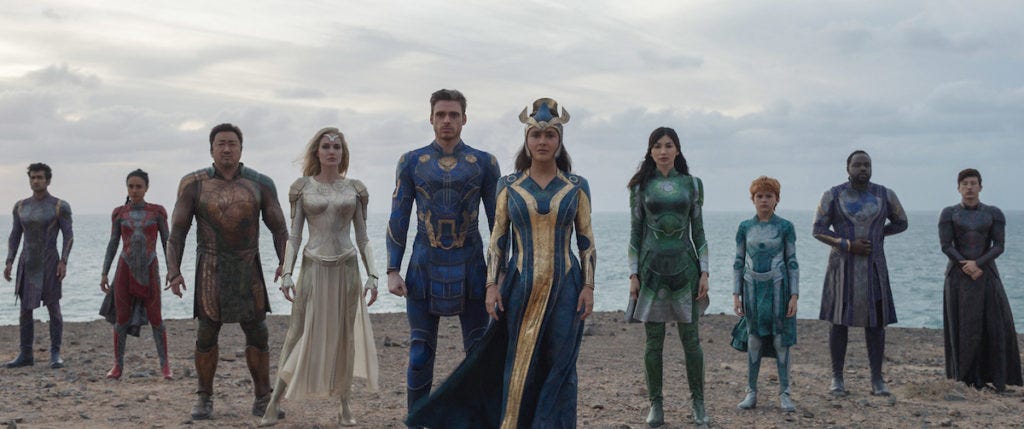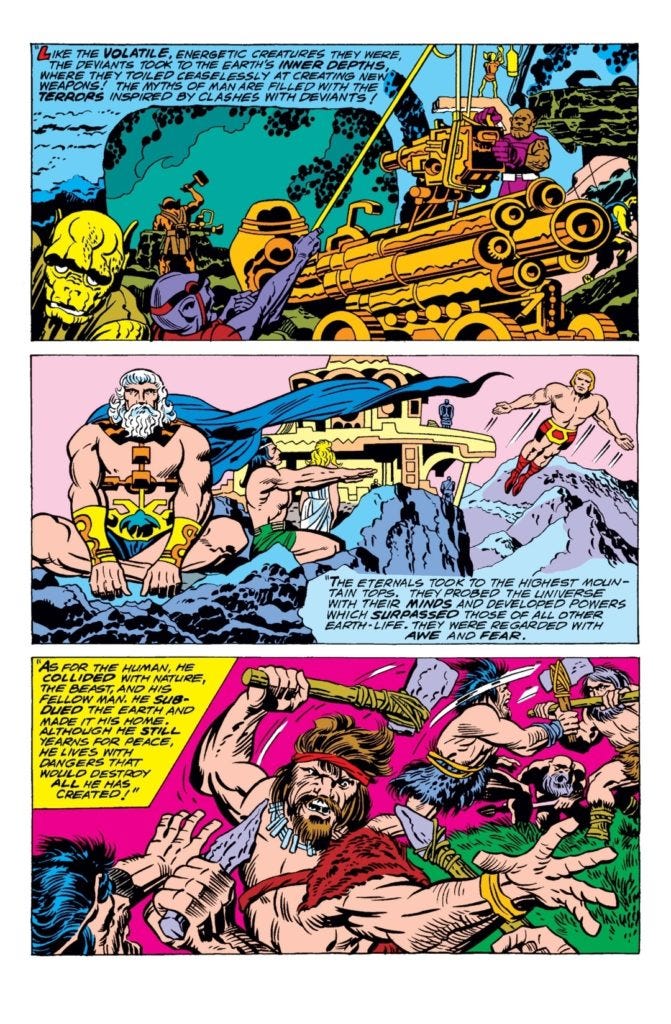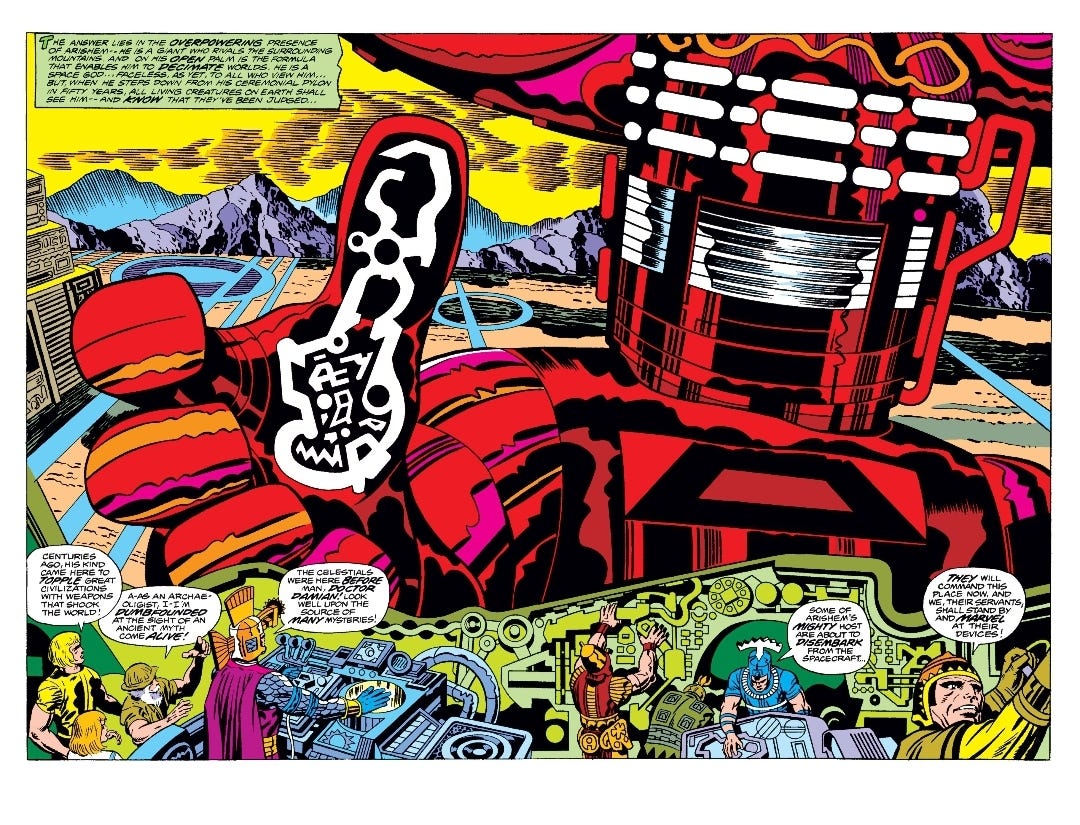Jack Kirby Runs Into the MCU Buzzsaw
‘Eternals’ and the irony of watching fans trumpet their allegiance to a corporation over artists.
Jack Kirby co-created what is now a multi-billion-dollar industry. It's his work that laid the foundation on which the Marvel Cinematic Universe was built. And it’s that same cinematic universe that has done everything it can to strip any elements of Kirby’s personality from the films. Sadly, the movie fans seem to prefer it this way.
Since the first Eternals trailer dropped in May, rabid MCU fans have defended the movie from any and all criticism. I experienced this when I noted that the muted colors of the first trailer seemed to be missing the vibrancy of Jack Kirby’s original work: I was hounded for days by fanboys and girls, many of whom finally settled on the suggestion that Jack Kirby’s legendary art looked silly. Last month, one user on twitter simply posted some images from Kirby’s original run on The Eternals, in contrast to the new film. Marvel stans replied that King Kirby’s work was “hideous” and “dumb,” with one going as far as to say, “glad the movie dont look like this, [this] look like rainbow vomit omg.” (Sic, throughout.)
Setting aside the aesthetic critique—different strokes for different folks, and all that—there’s something deeply depressing about the whole spectacle that has nothing to do with art. Jack Kirby spent his life fighting corporate behemoths and championing the rights of creators, as individuals, a war he didn’t win until after his death. But time and again, the fans have made it abundantly clear they care more about corporations than creators.

Jack Kirby started working on comics in the 1930s but didn’t have his first true success until he and frequent collaborator Joe Simon created Captain America in 1940. But it was in the 1960s that Kirby and creative partner Stan Lee would truly change the game: For a decade, Kirby co-created, drew, and arguably co-wrote, stories for characters such as The Fantastic Four, The X-Men, The Avengers, Black Panther, The Incredible Hulk, Thor, Iron Man, Ant-Man and Captain America.
Tired of Lee’s credit-hogging and hoping to earn a little more money while retaining creative control, Kirby left Marvel in 1970 for DC. While there he created Darkseid, The New Gods, Kamandi, Etrigan the Demon, and other characters that would go on to play a large role in DC comics (and films). He was always interested in gods as a concept (see: Thor), but his work became even more detailed and esoteric in this regard. There were human characters in these books, but they never felt like real people. The gods he wrote, however, had a grandeur and mythic quality about them. They truly felt god-like. Sales were decidedly mortal: The New Gods was canceled relatively quickly and when his contract was up he went back to Marvel.
It was at Marvel that he created The Eternals. In the world of The Eternals—at the time there was debate as to whether they belonged in the official Marvel continuity—alien gods called Celestials created three races: humans, Deviants, and Eternals. Humans we know, but The Eternals were immortal and honorable godlike beings who served as the inspiration for earth’s countless myths and gods. Their counterparts, The Deviants were misshapen and cruel; they were the basis for the many demons of myth. Kirby was never known for his subtlety and these creations continued the obsession he had with god-like beings representing the sides of good and evil.
The Eternals, like the New Gods, did not catch on with readers: After 19 issues and one annual, the book was canceled. Kirby left Marvel once again. However, his characters stuck around; while they never had great success, they became a permanent fixture of Marvel continuity and considered yet another beloved Kirby concept that never got its due.
Eternals the film eschews most of Kirby’s aesthetic for a more muted look, a heresy that didn’t keep me from enjoying it overall. Fans have spent months regurgitating the statement from Kevin Feige that much of the film was shot on location using natural light, but besides a few eye-catching outdoor compositions one might expect from the director of The Rider and Nomadland, it often looks much like any other Marvel film.

"Eternals" 1, July 1976
In Jack Kirby’s “The Eternals,” the Deviants are cartoon grotesqueries. Each major one has its own unique look. In the film however, they’re largely indistinguishable from each other (with one exception) and look like mutated computer-generated dogs. The Celestials do take inspiration from Kirby’s original creation but the muddled CGI visuals and the film’s muted color palette lacks the grandeur and pop of their comic book counterparts.
Eternals also doesn’t have as much interest in Kirby’s recurrent idea of good vs evil with humanity stuck in the middle of a struggle between gods. There are some human characters, such as Kingo’s valet, Sersi’s boyfriend and Phastos’s family, but they’re ultimately minor and pushed away from the plot fairly quickly. Only the valet sticks around for a chunk of the running time, and even then he’s merely comic relief. The Eternals themselves feel less godlike and more human; it’s frequently unclear what their powers (and perhaps more importantly, their weaknesses) really are.
Kirby’s human characters always felt undercooked, but he understood the importance of having them to contrast his world of gods and demons. His “Eternals” run focuses as much on the humans as it does the Eternals and the Deviants. Every corner of that triangle is vital: How can you have gods if there’s no one to worship them? (And no, quippy comic relief doesn’t count.)
For the most part, Marvel Studios has pushed Kirby’s work to the side. There have been exceptions; Taika Waititi’s Thor: Ragnarok borrowed much of its costume and set design from Kirby’s style. Overall, though, the studio has been more than happy to make films that rely more on the quips favored by Stan Lee than they do the operatic scale of Kirby.
In a way, that’s not surprising. After all, Marvel Studios made Lee a mascot of sorts, having him show up in dozens of Marvel productions over the years. Disney has brought that sensibility to their overarching Marvel Cinematic Universe. Though these films often go big and cosmic, just as Kirby did, there’s always a slight wink to the audience. Don’t take this too seriously, they seem to be saying. There’s always a joke to undercut any serious moment. It’s the struggle of the Lee/Kirby dynamic transported from the comic book page and into a multi-billion-dollar film series. Not that Kirby was entirely devoid of levity, but take a look at his 1960s Marvel era, with Lee writing dialogue for Kirby’s stories, versus his 1970s output where he was handling the writing entirely and not just the plots. Kirby was always about going bigger and grander. Lee may have tempered and undercut that when they worked together, but without him Kirby was free to explore his pet themes unencumbered. The big difference between the two men is Kirby took the stories he was telling seriously and Lee didn’t. No wonder Lee is Marvel’s Mickey Mouse.
Which brings me back to the fans. The last decade-plus of MCU dominance have acclimated fans to the dark and muddy visuals of Marvel Studios’ films. When presented the work of the man who made all this possible more than half a century ago, they reject it. Show them a Kirby panel or splash page and watch them performatively retch in reaction.
Meanwhile, when critics lightly pan Eternals, the fans (and fan media) pervert the language of social justice to bludgeon anyone who thinks the movie may have missed the mark. You don’t like Eternals? Well, why are you so sexist, racist, and homophobic that you would reject this movie directed by a woman, starring a multiracial cast, and featuring a single gay character? Ignore the fact that even though the MCU has been around since Iron Man came out in 2008 it took them until 2018 with Black Panther to release a film with a black hero as the main star. Ignore also that the same didn’t happen with a woman hero until 2019. Ignore further that before Phastos in Eternals the only LGBT representation was director Joe Russo playing a gay man in a support group lead by Captain America for a split second in Avengers: Endgame.
The MCU is a business, one focused on putting out content that gets the most butts in seats, artistry be damned. They didn’t cater to marginalized audiences because they didn’t see money in it. Now they do, and the fans are happy to follow along, willfully ignorant that Marvel Studios doesn’t care about them or their identities, let alone the work of the man who created what they love. The most striking example of this occurred fairly recently. When an actual opportunity for increasing social justice arose—that is, the possibility that the union of film trade workers, IATSE, might go on strike—the first concern of Marvel fans wasn’t for the workers improving their lives. No, it was whether or not some of the effects scenes in Spider-Man: No Way Home might look a little janky. Improving the lives of workers is worth much less than ensuring the next Ant Man isn’t delayed.




